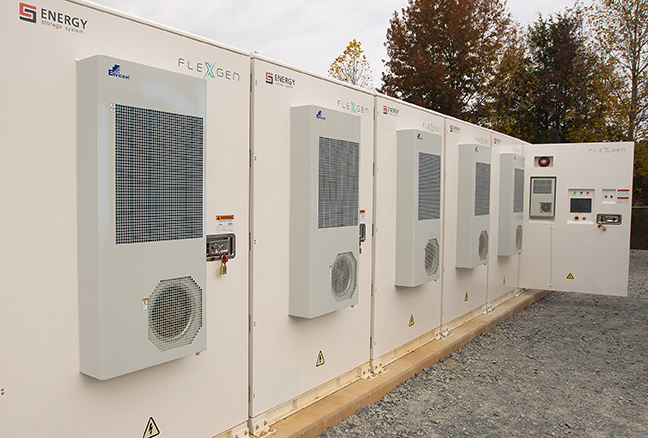Welcome!

The energy stored at REMC’s Five Points Substation can serve 1,800 members for five hours during an outage. Photo by Eric Abernathy / Randolph Hub
Battery up!
ASHEBORO — Randolph Electric Membership Corporation has flipped the switch to a battery-powered energy backup system.
The electric cooperative held an opening celebration on Oct. 27 at the Five Points Substation on Kemp Mill Road, where the Battery Energy Storage System (BESS) has been set up.
A total of 40 modules can produce five megawatts and 10 megawatt hours with the capability to serve 1,800 members for five hours during an outage. Each module has multiple batteries, each about the size of a cereal box. The BESS is integrated into the REMC grid.
Dale Lambert, chief executive officer of REMC, welcomed an invitation-only group that included US Rep. Ted Budd, NC Sen. Dave Craven and Randolph County commissioners Hope Haywood and Maxton McDowell. Also present were members of the REMC Board of Directors, Joe Brannan, CEO of the NC Electric Cooperatives, and representatives of FlexGen and Booth Associates.
Lambert called the event “a momentous occasion for REMC and the North Carolina cooperatives. This will reduce costs and improve the electric grid.”
In a prepared statement, Lambert added, “Randolph Electric is committed to innovation that advances our Brighter Future vision for electricity that is affordable, reliable and supports our sustainability goals. This battery installation allows us to reduce demand costs, strengthen the grid and reduce outage times for co-op member-owners."
The REMC battery substation is the first of 10 to be deployed in rural areas by NC Electric Cooperatives. The batteries will be charged during periods of low-demand for electricity and discharged when demand is high. It’s capable during an outage to provide power to a geographic location near the system.
Brannan told the assemblage that BESS is part of “something happening across the country and shows the leadership of REMC. The focus is on portable, reliable and resilient. It’s a unique project, the first stand-alone storage unit that will enhance the capability of reliable service. A system like this will mitigate outages.”
Dennis Mabe, REMC vice president of engineering operations, said each of the 40 modules “is like four or five Teslas (electric vehicles). When fully charged, they can provide electricity for two to three hours while crews are getting transmission lines back up.”
Budd called the battery system innovative and “an excellent solution. I applaud the planning and hard work.”
The REMC statement went on to say, “Installation of the battery energy storage system began earlier this year in January, and now REMC and North Carolina’s electric cooperatives announce the array’s activation. In addition to installing substation batteries, Randolph EMC and the network of cooperatives in North Carolina have worked together for years to lead innovative energy strategies, including community solar, microgrids, demand response programs and solar plus storage initiatives.”
Lambert concluded: “We will continue to lead the integration, management and optimization of resources and technologies that benefit our community and local member-owners, now and in the decades to come.”
